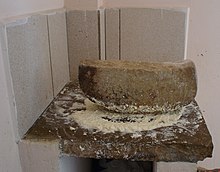

The batán is a kitchen utensil used to process different kinds of foods in South American, Andean and Indian cuisine. It has a flat stone (the batán proper) and a grinding stone called an uña. The uña is held in both hands and rocked over the food in the batán. Depending on the process wished, the uña's weight is slightly held back, let loose over, or pressed on. The rocking movements also vary depending on the procedure. The grinding is done dry or with water or oil.
South America[edit]
The batán has been used since before the arrival of Spaniards in South America.[1] In Andean households many different dishes are prepared in this manner, in rural and urban areas.[2] The most important use it has is for preparing llajwa. For many Bolivians, Peruvians, Ecuadoreans and Colombians it is not the same when done in a blender.
It is also used to husk grains, wash quinoa from its alkaloid (saponin), grind grains, crush papalisa and even to prepare small quantities of flour.


South Asia[edit]
In Nepal, it is known as silauto-lohoro.
It is also used in India in a large number of households.[3] It is known there as "sil-batta" in Hindi with sil referring to flat stone and batta referring to a cylindrical grinding stone. It is known as pata-varvanta in Marathi[4] and used in the state of Maharashtra. It is known as ammi kallu in Tamil[5] and Malayalam.[6] It is known as "shil nora" in Bengali and is basically found to be used in almost every household in West Bengal. In Odisha, it is called sila puaa where it is also worshipped as Bhu Devi or mother Earth during traditional Odia weddings and the Raja festival. It is traditionally used to grind spices and lentils in the states of Tamil Nadu and Kerala. These grinding stones are primarily used to prepare chutney and spice mixes for cooking and occasional use including grinding soaked lentils in preparation for dosas, vadas, or papadum.
See also[edit]
References[edit]
- ^ De La Vega, Garcilaso (2006). "Chapter 7: The Empire Before Arrival of the Spaniards - Maize and What They Call Rice, and Other Seeds". Royal Commentaries of the Incas and General History of Peru. p. 74. ISBN 9781603848565.
- ^ Morvelli, Walter Coraza "The Best Flavor in Cuzco’s Cooking Still Comes from the Batán, the Grinding Stones." 24 January 2013 Cusco Eats: Food and Culture of the Andes
- ^ A Feature on the Sil Batta – The traditional Stone Grinder of the Indian Kitchen" NMTV.tv March 3, 2011, Accessed March 4, 2017
- ^ "Bhimthadi Jatra: A melange of craftsmanship and tradition" December 13, 2014 The Times of India website, Retrieved March 4, 2017
- ^ [ta.wiktionary.org/wiki/அம்மி Meaning of the word in Tamil Wiktionary]
- ^ [ml.wiktionary.org/wiki/അമ്മി Meaning of the word in Malayalam Wiktionary]